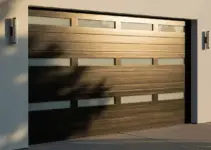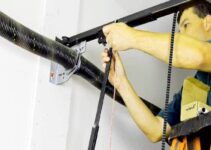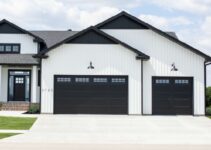You press the button, hear the motor hum, but the garage door stays put. Why? This is a common issue many homeowners face, and it can happen due to several reasons. Sometimes the fix is as simple as replacing the batteries in your remote control. Other times, the issue could be related to the mechanics of the door itself.
Let’s dive into how a garage door works and why it might not be opening even though the motor is running.
How Garage Doors and Motors Work
A typical garage door operates using an electric motor connected to a drive belt or chain that lifts and lowers the door. The motor receives a signal from the remote control or wall switch to open or close the door. Springs, tracks, and other hardware all work together to ensure smooth operation. But when one part of this system fails, your garage door can stop functioning properly, even if the motor is still working.
Common Reasons for a Garage Door Not Opening Despite the Motor Running
There are several potential culprits when your garage door won’t open, but the motor is running. Let’s take a closer look at the most common ones.
1. Battery Issues in the Remote Control
The simplest explanation could be that the batteries in your garage door remote control are dead. When the motor runs but the door doesn’t move, it’s a good idea to check if the remote is working properly by testing it with fresh batteries.
2. Obstructions in the Garage Door Tracks
Sometimes debris, dirt, or small objects can get lodged in the tracks of your garage door, preventing it from moving. Even if the motor is working, the door will not open if it’s blocked by something in the tracks.
3. Broken or Damaged Torsion Springs
Torsion springs are crucial for lifting the heavy garage door. If the springs break or become damaged, the door won’t be able to open, even though the motor is running. Broken springs require professional assistance, as they can be dangerous to replace on your own.
4. Misaligned Safety Sensors
Most garage doors are equipped with photo-eye sensors that prevent the door from closing on people or objects. If these sensors are misaligned or blocked, the door won’t open or close correctly. This is an easy fix that involves aligning the sensors properly or clearing any obstructions.
5. Drive Belt or Chain Problems
The drive belt or chain is responsible for moving the door up and down. If this part is broken, disconnected, or too loose, the motor will run, but the door won’t move. You can inspect this by looking at the connection between the motor and the garage door.
6. Issues with the Opener Settings
Sometimes, the issue lies in the garage door opener settings. If the travel limit or force settings are off, the door might stop prematurely or not open at all. These settings can be adjusted on the opener itself.
7. Manual Operation Check
If the door’s automatic function isn’t working, try disengaging the motor and opening the door manually. This will help determine if the issue is with the door’s mechanics or the motor itself.
Troubleshooting Steps for a Stubborn Garage Door
If you’re experiencing any of the above issues, follow these troubleshooting steps to fix the problem.
1. Replace Remote Control Batteries
Always start with the simplest fix. If your motor is running but the door isn’t moving, try replacing the remote control’s batteries first.
2. Clean and Inspect the Garage Door Tracks
Check the tracks for any debris or obstructions. Wipe them down and clear anything that might be in the way. Ensure that the tracks are properly aligned.
3. Check the Torsion Springs
If you suspect a broken or damaged spring, avoid trying to fix this on your own. Torsion springs can be dangerous and are best handled by a professional.
4. Align or Clean the Safety Sensors
Look for the photo-eye sensors on either side of the garage door. Make sure they’re properly aligned and clean of any dust, dirt, or obstructions.
5. Inspect the Drive Belt or Chain
If the drive belt or chain appears loose or broken, you might need to tighten it or replace it altogether. This is something that can typically be done by following the manufacturer’s instructions.
6. Adjust the Travel Limits
Consult your garage door opener’s manual to adjust the travel limits or force settings. If the door isn’t opening or closing all the way, this could be the problem.
7. Test Manual Operation of the Garage Door
Disengage the automatic motor and try opening the door manually. If it moves smoothly, the issue is likely with the motor or the opener settings.
When to Call a Professional
If you’ve tried the above troubleshooting steps and your garage door still won’t open, it’s time to call a professional technician. Issues like broken torsion springs or malfunctioning motors require specialized tools and expertise.
Preventive Measures to Avoid Future Garage Door Issues
To avoid future problems with your garage door, here are a few preventive measures:
- Regularly check and maintain your garage door tracks and springs.
- Ensure your remote control batteries are replaced when needed.
- Keep the area around your garage door free from obstructions.
- Schedule annual maintenance with a garage door professional.
Conclusion
Having a garage door that won’t open can be a frustrating experience, especially when the motor is running. By understanding the common causes and following the troubleshooting steps outlined in this article, you can resolve many issues on your own. However, always remember that some problems, like broken torsion springs, should be handled by a professional to ensure your safety.
FAQs
1. How often should I service my garage door?
It’s recommended to have your garage door professionally serviced at least once a year to ensure it’s functioning properly.
2. What should I do if the garage door sensor light is flashing?
A flashing sensor light indicates that the photo-eye sensors are misaligned or blocked. Simply adjust the sensors or clear any obstructions to fix the issue.
3. Can I replace the torsion springs on my own?
No, replacing torsion springs is dangerous and should be done by a trained professional. Attempting to do it yourself could result in serious injury.
4. How do I know if my garage door opener needs to be replaced?
If your garage door opener frequently malfunctions, doesn’t respond to the remote control, or makes unusual noises, it may be time to replace it.
5. Why does my garage door open but not close?
This could be due to a problem with the safety sensors or an issue with the travel limit settings. Check both to resolve the issue.


